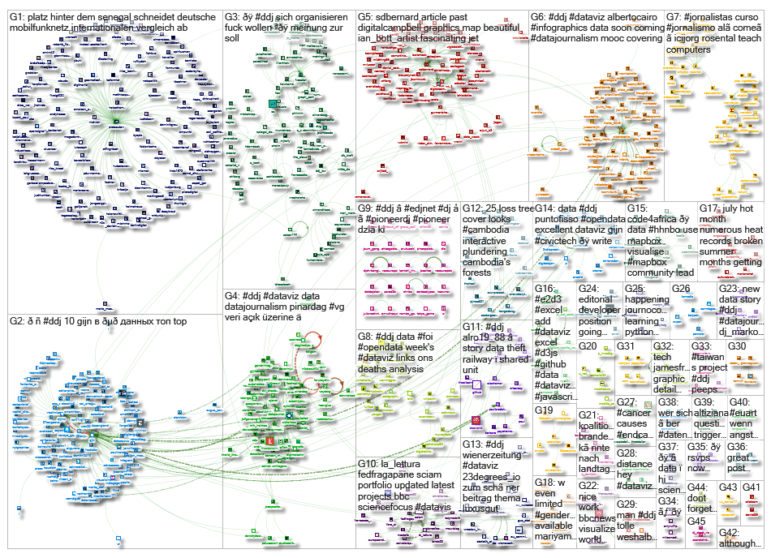What’s the global data journalism community tweeting about this week? Our NodeXL #ddj mapping from August 5 to 11 finds Spiegel Online analyzing the typical features in Quentin Tarantino’s films, MU Collective releasing an interactive “TheyDrawIt” tool to engage and educate readers, and the conversation on climate heating up — with 101 East Al Jazeera looking into Cambodian deforestation, Neue Zürcher Zeitung analyzing Swiss forest fires, and the Financial Times digging into the impact of jet streams on the climate.
Tarantino’s Curses & Killings
Fans of the movie Pulp Fiction already know this: The movie is littered with curses and vulgar language (a whopping total of 458 instances) — typical of Quentin Tarantino’s films. Spiegel Online analyzed and visualized the amount of curse words, deaths, murder weapons, and more used in nine Tarantino films. There’s also a quiz for you to test your Tarantino knowledge here. (In German.)
Der typische Tarantino als Animation – hier geht's zur Datenanalyse seiner letzten neun Filme -> https://t.co/3IHH11SS7U pic.twitter.com/lZM4ifMu6V
— Holger Dambeck (@hdambeck) August 12, 2019
TheyDrawIt Tool
Midwest Uncertainty Collective wondered what it would be like to encourage users to reflect on, and update, their beliefs as they interact with a graph. So the collective created the TheyDrawIt tool, where journalists can create line charts that allow readers to sketch their beliefs before they display the actual data.
MU Collective lead by @JessicaHullman and @mjskay introduces TheyDrawIt!, an "authoring tool that makes it easy to create line charts that ask users to sketch their beliefs before viewing data, and then optionally visualize other users’ beliefs."#dataviz https://t.co/91sZGOJSXl
— AnyChart (@AnyChart) July 19, 2019
Cutting Cambodia’s Forests
From 2001 to 2018, Cambodia lost 2.17 million hectares of tree cover — a 25% decrease, according to data analysis by Global Forest Watch. In some cases, protected areas have been completely destroyed — such as the Snuol Wildlife Sanctuary in eastern Cambodia. Al Jazeera maps out the cutting of Cambodia’s forests and looks at which countries have participated in the nation’s deforestation.
Check out #GoldmanPrize recipient Leng Ouch (Cambodia, 2016) in this interactive feature on his efforts to take down Cambodia's timber tycoons and expose illegal cross-border trade: https://t.co/C1gW9hYRnr via @AlJazeera
— Goldman Prize (@goldmanprize) August 6, 2019
Will 2019 Break Last Year’s Heat Records?
The summer of 2018 was a summer of extremes, in terms of heat waves and record high temperatures. But just a year later, it seems as if all the records from 2018 will melt away easily in 2019. Spiegel Online compares the temperatures, aridity, and rainfall of last year and this year across Germany. (In German.)
Very nice piece of data visualization by @SPIEGELONLINE Wetterdaten: Supersommer in Serie https://t.co/tlYsTRKa8R
— Matthias Stahl 🇪🇺 (@Bioschema) August 6, 2019
Visualize 2019’s DataViz Survey Results
The 2019 edition of the Data Visualization survey received over 1,350 responses, and suggests that more respondents thought it was their skills and lack of time, not inadequacy of tools, that held them back. The organizers are running a competition with prizes to visualize the results by September 8. Enter here.
Data for the 2019 #dataviz survey is available now. Last year the theme of responses was "design". This year, I was struck by how we don't seem to have enough time to do dataviz and what that says about the way organizations view & prioritize dataviz.https://t.co/m5pYXUDhPZ
— Elijah Meeks (@Elijah_Meeks) August 7, 2019
Geographic Data Resources
Geojournalism.org provides online resources, tutorials, and training in English and Portuguese for journalists, designers, and developers to dive into the world of data visualization using geographic data.
https://t.co/bBcG2gXbex, gazetecilerin tasarımcıların ve yazılımcıların coğrafi verileri kullanarak veri görselleştirme yapmaları çevrimiçi kaynaklar ile çeşitli eğitimler sunuyor.#açıkveri #veriokuryazarlığı #verigazeteciliği #verigörselleştirme #veribülteni#ddj #opendata
— VOYD (@voydorg) August 7, 2019
Data Literacy Crucial for Humanitarians
There is a need for humanitarians to build data skills. In a data literacy survey of humanitarian employees by the UN Office for the Coordination of Humanitarian Affairs (OCHA), almost all respondents (98.06%) reported that they engage in tasks related to data, with 70.11% working with data “all the time.” However, many respondents also said they faced challenges in collecting primary data and in assessing and improving its quality.
Why do all humanitarians need to build data skills? Read more ➡️ https://t.co/sJNJeVBTKE@UNOCHA pic.twitter.com/QiJt1ik1nm
— Centre for Humanitarian Data (@humdata) July 16, 2019
Quick, but Not Dirty, Data
Who has the best data journalism with the fastest methods? In a friendly competition, three teams of data journalists demonstrated how they produced time-driven and data-driven visual stories at this year’s Netzwerk Recherche conference. (In German.)
Eins haben wir (doch) noch: unser #nr19 Video zum Panel „Quick but not dirty“. Datenjournalisten von @DerSPIEGEL @NZZ & @SZ präsentieren in einem kleinen Wettbewerb, wie sie unter Zeitdruck datengetriebene, visuelle Geschichten realisieren. https://t.co/wc0wd3kxbC
— Netzwerk Recherche (@nrecherche) August 7, 2019
Forest Fires
The heat emitted from wildfires is not the only danger to humans: Soot particles and toxic gases like carbon monoxide and nitrogen oxides are also released. And the destruction of forests can cause erosion and mudslides. Neue Zürcher Zeitung takes a look at data on forest fires in Switzerland. (In English and German.)
A quick trip down process-lane (1/x) for those who want some deets about the how we built out the article. Here’s the board I constructed during the initial concept phase so we could have a good idea of the questions we wanted to cover. pic.twitter.com/yUjYRLTbmW
— anna wiederkehr (@wiederkehra) August 6, 2019
Impact of Jet Streams on the Climate Crisis
As the world gets warmer, the behavior and impact on climate of jet streams — fast-flowing, narrow, meandering air currents in the atmosphere — is an issue hotly debated by scientists. The Financial Times asked expert scientists to explain the phenomenon in an attempt to understand this critical part of climate science.
Beautiful graphics and map from @ian_bott_artist and @digitalcampbell in this fascinating article about how the jet stream affects our weather by @lesliehook https://t.co/op9l1iUpv9#ddj #gistribe #dataviz pic.twitter.com/RhW5yiXpl1
— Steven Bernard (@sdbernard) August 6, 2019
Thanks, once again, to Marc Smith of Connected Action for gathering the links and graphing them. The Top Ten #ddj list is curated weekly.
 Eunice Au is GIJN’s program coordinator. Previously, she was a Malaysia correspondent for Singapore’s The Straits Times, and a journalist at the New Straits Times. She has also written for The Sun, Malaysian Today and Madam Chair.
Eunice Au is GIJN’s program coordinator. Previously, she was a Malaysia correspondent for Singapore’s The Straits Times, and a journalist at the New Straits Times. She has also written for The Sun, Malaysian Today and Madam Chair.
For a look at Marc Smith’s mapping on #ddj on Twitter, check out this map.

